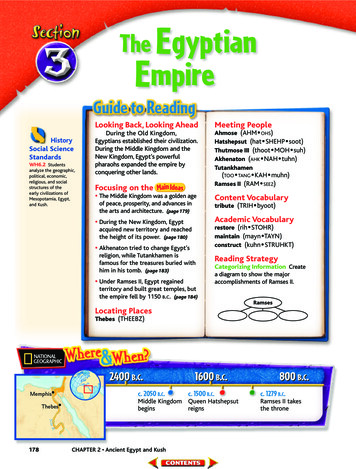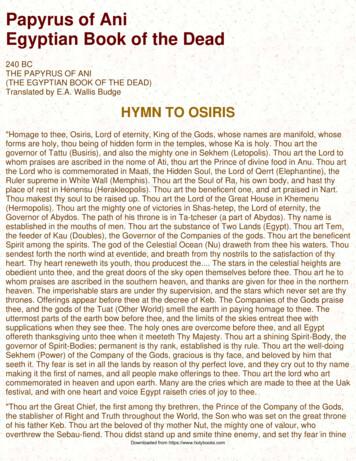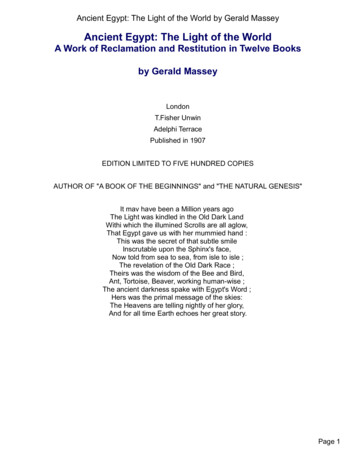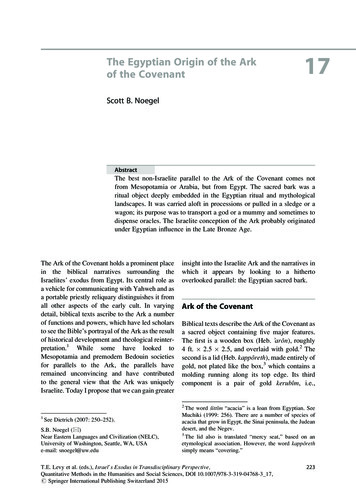
Transcription
The EgyptianEmpireHistorySocial ScienceStandardsWH6.2 Studentsanalyze the geographic,political, economic,religious, and socialstructures of theearly civilizations ofMesopotamia, Egypt,and Kush.Looking Back, Looking AheadMeeting PeopleDuring the Old Kingdom,Egyptians established their civilization.During the Middle Kingdom and theNew Kingdom, Egypt’s powerfulpharaohs expanded the empire byconquering other lands.Ahmose (AHM OHS)Hatshepsut (hat SHEHP soot)Thutmose III (thoot MOH suh)Akhenaton (AHK NAH tuhn)TutankhamenFocusing on the The Middle Kingdom was a golden ageof peace, prosperity, and advances inthe arts and architecture. (page 179)(TOO TANG KAH muhn)Ramses II (RAM SEEZ)Content Vocabularytribute (TRIH byoot)Academic Vocabulary During the New Kingdom, Egyptrestore (rih STOHR)maintain (mayn TAYN)construct (kuhn STRUHKT)acquired new territory and reachedthe height of its power. (page 180) Akhenaton tried to change Egypt’sreligion, while Tutankhamen isfamous for the treasures buried withhim in his tomb. (page 183) Under Ramses II, Egypt regainedReading StrategyCategorizing Information Createa diagram to show the majoraccomplishments of Ramses II.territory and built great temples, butthe empire fell by 1150 B.C. (page 184)RamsesLocating PlacesThebes (THEEBZ)2400 B.C.MemphisThebesc. 2050 B.C.c. 1500 B.C.Middle Kingdom Queen HatshepsutbeginsreignsN ileR.1781600 B.C.CHAPTER 2 Ancient Egypt and Kush800 B.C.c. 1279 B.C.Ramses II takesthe throne
WH6.2 Students analyze the geographic, political, economic, religious, and social structures of the early civilizations of Mesopotamia,Egypt, and Kush.WH6.2.5 Discuss the main features of Egyptian art and architecture.The Middle KingdomThe Middle Kingdom was a golden ageof peace, prosperity, and advances in the arts andarchitecture.Reading Connection Have you heard older peopletalk about enjoying their “golden years”? Countries canalso experience such happy, productive times. In thefollowing paragraphs, you’ll learn why the MiddleKingdom was a golden age for Egypt.About 2300 B.C., the pharaohs lost control of Egypt as nobles battled one anotherfor power. Almost 200 years of confusionfollowed. Finally, a new dynasty ofpharaohs came to power. They moved theircapital south from Memphis to a city calledThebes (THEEBZ). There they restored orderand stability, ushering in a new periodcalled the Middle Kingdom.The Middle Kingdom lasted from about2050 B.C. to 1670 B.C. During this interval,Egyptians enjoyed a golden age of stability,prosperity, and achievement.The Drive for More LandDuring theMiddle Kingdom, Egypt took control ofnew lands. Soldiers captured Nubia to thesouth and attacked what is now Syria. Theconquered peoples sent tribute (TRIH byoot), or forced payments, to the Egyptianpharaoh, enriching the kingdom.Within Egypt, the pharaohs added morewaterways and dams. They increased theamount of land being farmed and built acanal between the Nile River and the Red Sea.This artwork with gold inlay from the MiddleKingdom period shows a funeral boat. How didarchitecture change during the Middle Kingdom?The Arts BlossomDuring the MiddleKingdom, arts, literature, and architecturethrived. Painters covered the walls of tombsand temples with colorful scenes of thedeities and daily life. Sculptors created largewall carvings and statues of the pharaohs,showing them as ordinary people ratherthan godlike figures. Poets wrote lovesongs and tributes to the pharaohs.A new form of architecture was alsocreated. Instead of building pyramids,pharaohs had their tombs cut into cliffswest of the Nile River. This area becameknown as the Valley of the Kings.Who Were the Hyksos?Web Activity Visit ca.hss.glencoe.comand click on Chapter 2—Student Web Activity tolearn more about ancient Egypt.The MiddleKingdom came to an end in 1670 B.C.Nobles were again plotting to take powerfrom the pharaohs. This time, however,Egypt also faced a serious threat from outside. A people known as the Hyksos (HIHK SAHS), from western Asia, attacked Egypt.CHAPTER 2 Ancient Egypt and Kush179
WH6.2 Students analyze the geographic, political, economic, religious, and social structures of the early civilizations of Mesopotamia,Egypt, and Kush. WH6.2.6 Describe the role of Egyptian trade in the eastern Mediterranean and Nile valley. WH6.2.7 Understandthe significance of Queen Hatshepsut and Ramses the Great.The Hyksos were mighty warriors. Theycrossed the desert in horse-drawn chariotsand used weapons made of bronze andiron. Egyptians had always fought on footwith copper and stone weapons. They wereno match for the invaders.The Hyksos ruled Egypt for about 120years. Then, around 1550 B.C., an Egyptianprince named Ahmose (AHM OHS) led anuprising that drove the Hyksos out ofEgypt.Explain What advances inart were made during the Middle Kingdom?The New KingdomDuring the New Kingdom, Egypt acquirednew territory and reached the height of its power.Reading Connection Do you know the names of anywomen who hold political office? In ancient civilizations, women rarely held positions of power. Read tolearn how a woman became ruler of Egypt.Ahmose’s reign in Egypt began a periodknown as the New Kingdom. During thistime, from about 1550 B.C. to 1080 B.C., Egyptbecame even richer and more powerful.Hieroglyphs andComputer IconsThe ancient Egyptian system of writing wasmade up of hundreds of different characters calledhieroglyphs. Each hieroglyph was a picture thatrepresented a word. For example, a largecircle with a smaller circle drawn in itscenter meant “sun.” Egyptian scribescarved hieroglyphic symbols onmonuments and used them for everydaycommunication.Computer iconsToday, millions of peopleuse computer icons as symbols forwords and even emotions in e-mailsand other electronic communication.These icons are pictures—such as flagsor paper clips—that represent otherthings. In what way are hieroglyphs andcomputer icons similar?Hieroglyphs180Gianni Dagli Orti/CORBISCHAPTER 2 Ancient Egypt and Kush
Egyptian KingdomsNNILE DELTAEW40 ESGiza30 NARABIANPENINSULAMemphisLOWEREGYPT0300 mi.0300 kmLambert AzimuthalEqual-Area projectionRedaThebesSeWhen Hatshepsutdied, her nephew, Thutmose III (thoot MOH suh), became pharaoh. Thutmose’s armiesexpanded Egypt’s borders north to theEuphrates River in Mesopotamia. Histroops also moved south and regainedcontrol of Nubia, which had broken freefrom Egypt earlier.Thutmose’s empire grew rich from tradeand tribute. In addition to claiming gold,copper, ivory, and other valuable goodsSYRIAMediterranean SeaR.Expanding the EmpireCyprusileNnamed Hatshepsut (hat SHEHP soot) cameto power in Egypt. She ruled first with herhusband and then, after his death, on behalfof her young nephew. Finally she madeherself pharaoh. Hatshepsut became one ofthe few women to rule Egypt.Hatshepsut was more interested intrade than conquest. During her reign,Egyptian traders sailed across the easternMediterranean and south along the eastcoast of Africa. One product Egyptianswanted to find was wood. The Nile Valleyhad few trees, and the Egyptians neededwood for boats and for wood cabinets thatthe upper class liked to have in their homes.The search for wood took Egyptiantraders to the east coast of the MediterraneanSea where the country of Lebanon is locatedtoday. The area had many trees, and the people in the region, called the Phoenicians,were famous for their crafts. They madebeautiful wooden furniture and were amongthe first people to learn how to make glass.The Egyptians traded wheat as well aspaper, gold, copper, and tools for Phoenicianwood and furniture. The Phoenicians thentraded Egyptian goods to other people. Inthis way, Egyptian food and goods spreadacross the Middle East. Egypt’s trade in theeastern Mediterranean helped make thekingdom wealthier.40 E30 EA Woman Ruler About 1473 B.C., a queenTROP IC OF CANCERKEYUPPEREGYPTOld KingdomLand added duringMiddle KingdomLand added duringNew KingdomPyramids20 N1. Movement Which kingdom included landsacross the Mediterranean Sea?2. Place What physical feature makes up muchof the eastern border of the MiddleKingdom?from conquered peoples, Egypt enslavedmany prisoners of war. These unfortunatecaptives were put to work rebuildingThebes. They filled the city with beautifulpalaces, temples, and monuments.Slavery had not been widespread inEgypt before. During the New Kingdom,however, it became common. Enslaved people did have some rights. They could ownland, marry, and eventually be grantedtheir freedom.Summarize DescribeEgyptian trade during the rule of Hatshepsut.CHAPTER 2 Ancient Egypt and Kush181(l)Smithsonian Institution, (r)file photo
6.4.6. Compare and contrast life in AthensWH6.2.7UnderstandtheofandSparta, withemphasisonsignificancetheir rules inQueenHatshepsutand RamsesWars.the Great.thePersianand PeloponnesianHATSHEPSUTHatshepsutReigned 1473–1458 B.C.Hatshepsut was the daughter of King Thutmose I andQueen Aahmes. Even as a young princess, she was confident,describing herself as “exceedingly good to look upon . . . abeautiful maiden” who was “serene [peaceful] of nature.”During her marriage to King Thutmose II, Hatshepsutinfluenced her husband’s decisions and hoped to somedayhave more power. She saw an opportunity when Thutmosedied and declared herself pharaoh.Because the position of pharaoh was usually passed fromfather to son, Hatshepsut had to prove that she was a goodleader. She often wore men’s clothing to convince the peoplethat she could handle what had always been a man’s job.Unlike other pharaohs, Hatshepsut avoided militaryconquests. She focused her attention instead on expandingEgypt’s economy. She restored Egypt’s wealth through tradewith Africa, Asia, and throughout the eastern Mediterranean.Returning home from trading expeditions, cargo ships wereloaded with wood, ebony, furniture, ivory, incense, andmyrrh. During her reign, Hatshepsut also rebuilt many ofEgypt’s great temples, including the temple at Karnak. In hertemple at Deir el Bahri, the reliefs on the walls recorded themajor events of Hatshepsut’s reign.“A dictator excellentof plans”—Egyptian scribe quoted inBarbarian TidesMake a list of Hatshepsut’s strengths as a leader.Then choose a present-day female leader andlist her leadership strengths. Write a paragraphcomparing their similarities and differences.Hatshepsut’s templeat Deir el-Bahri182
WH6.2.3 Understand the relationship between religion and the social and political order in Mesopotamia and Egypt.Legacies of Two PharaohsAkhenaton tried to change Egypt’sreligion, while Tutankhamen is famous for thetreasures buried with him in his tomb.Reading Connection If you ask people to name anEgyptian pharaoh, the answer you’re likely to get is“King Tut.” Read on to find out more about him andhis predecessor.About 1370 B.C., Amenhotep IV (AH muhn HOH TEHP) came to the throne. Withthe help of his wife, Nefertiti (NEHF uhr TEET ee), Amenhotep tried to lead Egyptin a new direction.A Religious ReformerAmenhotep realizedthat Egypt’s priests were gaining power atthe expense of the pharaohs. In an attempt tomaintain his own power, Amenhotep introduced a new religion that swept away theold gods and goddesses. Instead, only onegod, called Aton (AH tuhn), was to be worshiped.When Egypt’s priests resisted thesechanges, Amenhotep removed many fromtheir positions, seized their lands, and closedtemples. He then changed his name toAkhenaton (AHK NAH tuhn), which means“Spirit of Aton.” He began ruling Egypt froma new city far from Thebes.To most Egyptians, Akhenaton’sattacks on the gods seemed to be an attackon Egypt itself. They refused to acceptAton as the only god.Meanwhile, Akhenaton became sodevoted to his new religion that he neglected his duties as pharaoh. The administrators he appointed were not asexperienced as the priests they replaced,and Akhenaton took no action when theHittites, enemies from what is now Turkey,attacked Egypt. As a result, Egypt lostmost of its lands in western Asia, greatlyshrinking the empire.Cats in Ancient EgyptIn ancientEgypt, cats were loved and evenworshiped. Egyptians valued the abilityof wild cats to protect villages’ grainsupplies from mice and rats. Overseveral hundred years, cats becametame, and their role developed fromvalued hunter to adored family pet togoddess.In ancient Egyptian tombs,archaeologists have found many wallpaintings, carvings, and statues of cats.Often the statues were adorned withbeautiful jewelry, such as silver or goldearrings, nose rings, and collars. Whenan Egyptian family’s cat died, its ownersshaved their eyebrows toshow their grief and had thecat’s body mummified.Egyptians worshipedcats because they associatedthem with the goddessBastet. She representedmotherhood, grace, andbeauty, and often appearsin paintings and statues asEgyptiana woman with the head ofgoddessdepicteda cat.as a catConnecting to the Past1. Why did ancient Egyptians first value cats?2. With what goddess did the ancientEgyptians associate cats?Metropolitan Museum of Art, Rogers Fund and Edward S. Harkness Gift,1929 (29.3.3)
The End of the New KingdomTutankhamen’sgold maskUnder Ramses II, Egypt regained territory and built great temples, but the empire fell by1150 B.C.Reading Connection Egypt remained mighty forthousands of years, but it finally fell to outsiders. Readto learn about Egypt’s last great pharaoh and theempire’s decline.The Boy KingWhen Akhenaton died, hisson-in-law inherited the throne. The newpharaoh, Tutankhamen (TOO TANG KAH muhn), was a boy about 10 years old. Herelied on help from palace officials andpriests, who convinced him to restore theold religion. After ruling for only nineyears, Tutankhamen died unexpectedly. Hemay have suffered a fall or been murdered;no one is sure.What is certain is that “King Tut,” as he isnicknamed, played only a small role inEgypt’s history. Why, then, is he the mostfamous of all pharaohs? The boy king captured people’s imaginations after a Britisharchaeologist, Howard Carter, found histomb in A.D. 1922.The tomb contained the king’s mummyand incredible treasures, including a brilliantgold mask of the young pharaoh’s face.Carter’s find was a thrilling discovery,because most royal tombs in Egypt werelooted by robbers long ago.Evaluate Why was the discovery of Tutankhamen’s tomb so important?184CHAPTER 2 Ancient Egypt and KushDuring the 1200s B . C ., pharaohsworked to make Egypt great again. Themost effective of these pharaohs wasRamses II (RAM SEEZ ) . He reigned for aremarkable 66 years, from 1279 B.C. to 1213B . C . During this time, Egyptian armiesregained lands in western Asia and rebuiltthe empire. Ramses also launched anambitious building program, constructingseveral major new temples.Temple of KarnakErich Lessing/Art Resource, NYWH6.2.3 Understand the relationship between religion and the social and political order in Mesopotamia and Egypt.WH6.2.7 Understand the significance of Queen Hatshepsut and Ramses the Great.
6.4.6. Compare and contrast life in AthensWH6.2.7UnderstandtheofandSparta, withemphasisonsignificancetheir rules inQueen Hatshepsut and Ramses the Great.RAMSES IIReigned 1279–1213 B.C.Statue of Ramses IIholding an offeringtableRamses II began his military training at a very young age.Ramses’ father, Seti I, allowed his 10-year-old son to serve asa captain in his army. Seti also made his son co-ruler of Egypt.By the time Ramses was crowned pharaoh of Egypt, he was agreat warrior and an experienced leader. Nine kings who ruledafter Ramses II named themselves in his honor. Manycenturies later, archaeologists nicknamed the pharaoh“Ramses the Great” because of his fame on the battlefield, hisconstruction and restoration of buildings and monuments,and his popularity among the Egyptian people. His subjectsfondly called him “Sese,” an abbreviation of Ramses.Ramses continued in his father’s footsteps by trying torestore Egyptian power in Asia. Like many New Kingdompharaohs, Ramses did this through warfare. He securedEgypt’s control of the nearby region of Canaan, an area where—hieroglyphic translationthe ancient Israelites later lived. In the early years of his reign,by James B. Pritchard,AncientNear Eastern TextsRamses defeated forces in southern Syria and continuouslybattled Egypt’s longtime enemy, the Hittites. Details aboutone costly battle with the Hittites were carved on temple walls,showing the Egyptians succeeding against great odds.During his 66-year reign, Ramses II undertook a largescale building program. He could afford such an expensiveplan because Egypt was very prosperous during his reign. Herestored the damaged Sphinx, completed the Temple ofKarnak, and built himself a city with four temples as well asbeautiful gardens and orchards. He is famous for the templebuilt at Abu Simbel. It was carved out of a solid rock cliff andfeatured four huge statues of Ramses II, two on each side ofthe doorway.“They all came bowingdown to him, to hispalace of life andsatisfaction.”Use the Internet and your local library to learnabout Mount Rushmore, a monument in SouthDakota. Describe Mount Rushmore, and thencompare it to the temple of Ramses at Abu Simbel.Coffin of Ramses II185(t)Egyptian National Museum, Cairo/SuperStock, (b)Gavin Hellier/Getty Images
Why Were Temples Built? Under RamsesII and other New Kingdom rulers, scores ofnew temples rose throughout Egypt. Manywere built by enslaved people captured inwar. The most magnificent was Karnak atThebes. Its huge columned hall decoratedwith colorful paintings still impresses visitors today.Unlike modern churches, temples, andmosques, Egyptian temples did not holdregular religious services. Instead, mostEgyptians prayed at home. They consideredthe temples as houses for the gods and goddesses. Priests and priestesses, however, performed daily temple rituals, washing statuesof the deities and bringing them food.The temples also served as banks.Egyptians used them to store valuableitems, such as gold jewelry, sweet-smellingoils, and finely woven cloth.Egypt’s Decline and Fall After Ramses II,Egypt’s power began to fade. Later pharaohshad trouble keeping neighboring countriesunder Egyptian control. Groups from theeastern Mediterranean attacked Egypt by sea,using strong iron weapons. The Egyptianshad similar arms, but they paid dearly forthem because Egypt lacked iron ore.By 1150 B.C., the Egyptians had lost theirempire and controlled only the Nile delta.Beginning in the 900s B.C., Egypt cameunder the rule of one outside group afteranother. The first conquerors were theLibyans from the west. Then, about 750 B.C.,the people of Kush, a land to the south,began to conquer Egypt. Finally, in 670 B.C.,Egypt was taken over by the Assyrians, apowerful society from the north.Analyze Why did Egyptianrulers lose control of their empire?Study Central Need help with the reigns ofHatshepsut and Ramses the Great? Visitca.hss.glencoe.com and click on Study Central.Reading SummaryReview the During the Middle Kingdom, Egyptexpanded its borders, and the artsflourished. Under New Kingdom rulers,Egypt built a strong empire andexpanded trade. Akhenaton failed in his attemptto create a new religion.Tutankhamen ruled briefly butgained fame because of treasuresfound buried with him.What Did You Learn?1. What improvements did theMiddle Kingdom rulers make?2. What purposes did templesserve in Egypt?Critical Thinking3. Organizing InformationCreate a chart like the onebelow. Fill in details aboutEgypt’s Middle Kingdom andEgypt’s New Kingdom.CA 6RC2.44. Evaluate Why was the reignof Hatshepsut consideredunusual? CA 6RC2.65.How didAkhenaton upset the traditional order in Egypt?CA HI2.6. Compare and ContrastDescribe the similarities anddifferences between the rule ofHatshepsut and Ramses II.CA 6WS1.3Middle Kingdom Ramses II was Egypt’s last greatpharaoh. In the 900s B.C., Egyptlost power to outside invaders.New Kingdom7. Expository Writing WhichEgyptian ruler do you think hadthe greatest effect uponEgyptian history? Write a shortessay to explain your answer.CA 6WA2.2186CHAPTER 2 Ancient Egypt and Kush(t)Michael Holford, (b)O. Louis Mazzatenta/National Geographic Society Image Collection
Within Egypt, the pharaohs added more waterways and dams. They increased the amount of land being farmed and built a canal between the Nile River and the Red Sea. The Arts BlossomDuring the Middle Kingdom, arts, literature, and architecture thrived. Painters covered the walls of tombs and te










